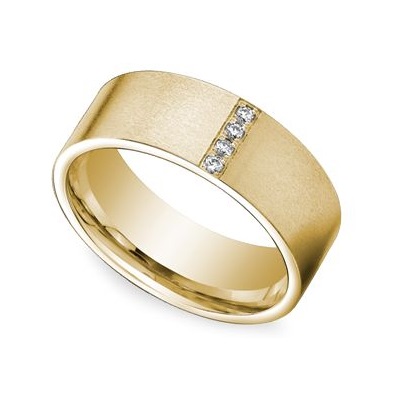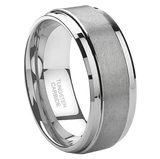Gold Rings
GOLD RINGS
Gold was first discovered as a shining yellow nugget, and they are obtained by panning.
Gold is called a "noble" metal (an alchemistic term) because it does not oxidize under ordinary conditions. Its chemical symbol Au is derived from the Latin word "aurum." In pure form, gold has a metallic luster and is sun-yellow. Pure gold is relatively soft -- it has about the hardness of a penny. It is the most malleable and ductile of metals.

The first firm evidence we have of human interaction with gold occurred in ancient Egypt around 3,000 B.C. Gold played an important role in ancient Egyptian mythology and was prized by pharaohs and temple priests. It was so important, in fact, that the capstones on the Pyramids of Giza were made from solid gold.
The ancient Greeks viewed gold as a social status symbol and as a form of glory amongst the immortal gods and demigods. Mortal humans could use gold as a sign of wealth and gold was also a form of currency. Contrary to what you might think, the Olympics tradition of giving out gold medals to victors did not begin until the modern Olympics and has little to do with Greek tradition.
Gold is also mentioned in the Bible, where Genesis 2:10-12 describes the lands of Havilah, near Eden, as a place where good gold can be found. Incans, Aztecs, and numerous other civilizations also used gold prolifically throughout the early history, including it in religious ceremonies and in famous architectural designs.
The degree of purity of native gold, bullion (bars or ingots of unrefined gold), and refined gold is stated in terms of gold content. "Fineness" defines gold content in parts per thousand. For example, a gold nugget containing 885 parts of pure gold and 115 parts of other metals ,such as silver and copper, would be considered 885-fine. "Karat" indicates the proportion of solid gold in an alloy based on a total of 24 parts. Thus, 14-karat (14K) gold indicates a composition of 14 parts of gold and 10 parts of other metals. Incidentally, 14K gold is commonly used in jewelry manufacture. Gold is still being dispersed throughout the geological world though it is believed to be the first metal known to the early hominids.
Gold became a part of every human culture. Its brilliance, natural beauty, and luster, and its great malleability and resistance to tarnish made it enjoyable to work and play with.
Early civilizations equated gold with gods and rulers, and gold was sought in their name and dedicated to their glorification. Humans almost intuitively place a high value on gold, equating it with power, beauty, and the cultural elite.
Gold, beauty, and power have always gone together. Gold is one of the few elements that can affect politics and economics. Wars have been fought over access to gold. Cities and towns have sprung up and died out as gold was discovered and then mined out.
Today jewelers have access to a lot of metals in different colors. Gold has been called the most beautiful of all chemical elements. Its beauty has made it desirable for use in jewelry, coins, and artwork for thousands of years. It was one of the first pure metals to be used by humans, other metals like platinum and palladium might be becoming popular but gold has always been a greater choice for over generations.
There are three types of gold rings. Having the knowledge about the different types of gold helps you narrow down your options when choosing the metal to use on the jewellery and enables you to make well informed decisions.
1. Yellow gold; yellow gold may appear to be pure gold, and that's what is believed by most people, but it is instead a combination of gold and different metals like zinc and copper.
Gold's purity or quality is measured in karats; the higher the actual amount of gold the higher the karat amount, but the less its durability. 14 - 18k is the standard amount for wedding rings to help them withstand the conditions of everyday wear leaving with a beautiful golden hue. Yellow gold can easily be scratched and dented because of the high amounts of karats. It needs to be cleaned and polished regularly. Yellow gold, historically, is the most popular metal for wedding rings and engagement rings.

2. White gold; white gold is an alloy of gold and a white metal such as palladium, manganese, or nickel. White gold rings often contain nickel which provides the strength needed for a durable setting that lasts. White gold is stronger and more durable, meaning it is less susceptible to scratching and denting. It needs maintenance, cleaning and polishing just like any other precious metal.

Though white gold that contains nickel can cause allergic reactions in some people with sensitive skin. If you have a nickel allergy and want to wear white gold, you will need to choose jewelry made with a nickel-free alloy.
White gold looks good on all skin tones.

3. Rose gold; this is a gold and copper
alloy that is sometimes referred to as red gold or pink gold. Rose gold is
a rare choice of rings, though it is its becoming a popular choice among people
who want their wedding and engagement rings to have a unique, romantic look.
Rose gold is more appealing in vintage-inspired engagement rings and wedding
rings. It can be combined with white or yellow gold to create a unique
multicolored setting that appeals to the wearer’s artistic side.
Rose gold is the strongest of the three, as copper is very sturdy and the resulting alloy is tougher than yellow or white gold. Rose gold is a fantastic choice for people with warm skin tones as well as for those with cooler skin tones.
Recent Posts
-
Wedding Rings for Men – Origin, Significance, Cost, and Tips to Choose
Men’s Wedding Bands – Origin, Significance, Cost, and Tips to Choose Every culture h …25th Aug 2020 -
Everything You Wanted to Know About Wedding Rings
Everything You Wanted to Know About Wedding RingsWeddings bands are now in-trend. Grooms never had …25th Aug 2020 -
Tungsten Versus Gold Wedding Bands
Tungsten Versus Gold Mens Wedding Bands - we decided more needed to be written about this subj …25th Aug 2020


